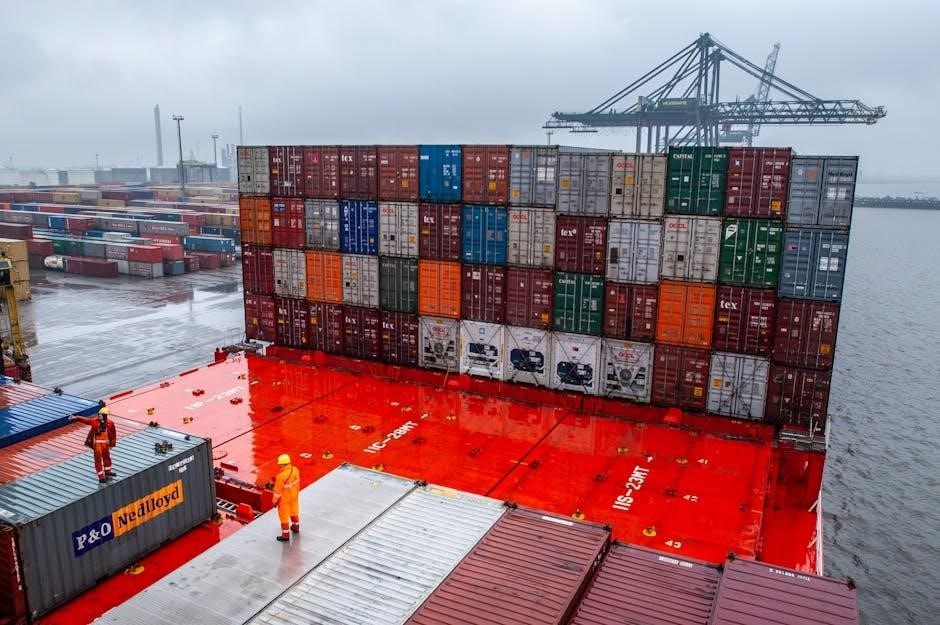P&I diagrams are detailed graphical representations of process systems, showcasing piping, vessels, valves, and instrumentation. They use standardized symbols to illustrate functional relationships and control systems, aiding engineers in designing and operating plants efficiently. A downloadable PDF guide is available for quick reference.
1.1. What is a P&I Diagram?
A Piping and Instrumentation Diagram (P&I Diagram) is a detailed graphical representation of a process system. It illustrates the piping, vessels, control valves, instrumentation, and other equipment used in the system. P&I Diagrams are essential in process industries as they provide a clear visual representation of how equipment and control systems are interconnected. These diagrams use standardized symbols to represent components such as valves, actuators, sensors, and controllers, ensuring consistency and clarity. They are crucial for designing, operating, and maintaining process plants, as they help engineers and technicians understand the functional relationships between different parts of the system. Additionally, P&I Diagrams are often accompanied by downloadable PDF guides that provide comprehensive lists of symbols and notation, making it easier for professionals to reference and use these symbols in their projects. These resources are invaluable for both beginners and experienced engineers working on piping and instrumentation projects.
1.2. Importance in Process Engineering
In process engineering, P&I Diagrams are indispensable tools for ensuring the safe, efficient, and reliable operation of industrial processes. These diagrams provide a comprehensive visual representation of the entire system, making it easier to understand complex interactions between equipment, instruments, and controls. By standardizing the depiction of components and their relationships, P&I Diagrams facilitate effective communication among engineers, technicians, and operators. This clarity is critical during the design, construction, and maintenance phases of a project. Additionally, P&I Diagrams play a key role in process safety by identifying potential hazards and ensuring compliance with industry standards. They also serve as valuable training aids for new personnel and as reference materials for troubleshooting and modifications. Without P&I Diagrams, process engineering projects would lack the precision and transparency needed to operate successfully in industries such as oil and gas, chemical manufacturing, and power generation.


1.3. Brief History of P&I Diagrams
The origin of P&I Diagrams dates back to the early 20th century, when industrial processes became increasingly complex. As industries like oil refining and chemical manufacturing expanded, the need arose for detailed, standardized diagrams to document process systems. Initially, these diagrams were rudimentary, often hand-drawn and varying in format. The 1940s and 1950s saw the introduction of standardized symbols by organizations like the International Society of Automation (ISA) and the American Society of Mechanical Engineers (ASME), which formalized P&I Diagrams. This standardization improved clarity and consistency across industries. The advent of computer-aided design (CAD) in the latter half of the 20th century revolutionized the creation and updating of P&I Diagrams, enabling faster and more accurate representations. Today, P&I Diagrams remain essential tools in process engineering, with ongoing updates to standards ensuring they meet the demands of modern industrial practices.

Standard P&I Symbols

Standard P&I symbols represent equipment, instruments, and piping in process systems. These symbols, defined by organizations like ISA and ASME, ensure consistency and clarity in diagram interpretation across industries.

2.1. Lines and Piping Symbols
Lines and piping symbols are fundamental components of P&I diagrams, representing the flow of materials and utilities in a process system. These symbols are standardized to ensure clarity and consistency. Common symbols include continuous lines for process streams, dashed lines for utilities like water or steam, and wavy lines for drains or vents. Each line type is often annotated with arrows to indicate flow direction or labels for fluid types. Piping symbols also include connections, bends, and reductions, which are essential for understanding the physical layout of the system. These symbols are critical for engineers to identify process pathways, troubleshoot issues, and plan maintenance activities. Proper use of these symbols ensures accurate interpretation of the diagram, making them indispensable in process engineering and design. Their standardized representation simplifies communication among engineers and technicians, ensuring safe and efficient system operation.
2.2. Valve and Actuator Symbols
Valve and actuator symbols are essential in P&I diagrams to represent flow control devices and their operation. These symbols indicate the type of valve, such as gate, globe, ball, or check valves, and whether they are manually or automatically actuated. Actuator symbols are often shown attached to valve symbols, with lines or arrows indicating control signals. Common actuator types include electric motors, pneumatic cylinders, or hydraulic operators. The symbols also differentiate between normally open (NO) or normally closed (NC) configurations, crucial for understanding control logic. Proper representation ensures clear communication of valve operation and control methods in process systems. These symbols are vital for engineers to design, operate, and troubleshoot process control systems efficiently. Standardized representations simplify interpretation, enabling seamless collaboration among teams. Accurate use of valve and actuator symbols ensures safe and reliable system performance, making them a cornerstone of P&I diagrams in process engineering. Their clarity is essential for effective system design and maintenance planning.
2.3. Instrumentation Symbols
Instrumentation symbols are critical in P&I diagrams to represent measurement and control devices. These symbols denote instruments like flow meters, pressure gauges, temperature sensors, and level transmitters. They also depict control elements such as controllers, sensors, and alarms. Instrumentation symbols often include lines or connections to show data flow or signal transmission between devices. For example, a temperature instrument may be shown with a sensor connected to a transmitter and a control unit. These symbols are standardized to ensure clarity and consistency, enabling engineers and technicians to interpret the system’s monitoring and control logic effectively. Proper use of instrumentation symbols ensures accurate representation of process control strategies, making it easier to design, troubleshoot, and maintain systems. They are indispensable for illustrating how data is acquired, processed, and used in process engineering applications. Standardized instrumentation symbols also facilitate collaboration among teams and ensure reliable system operation. Their precise depiction is vital for accurate P&I diagram interpretation.
Common P&I Symbols by Category
P&I diagrams use categorized symbols for valves, instruments, pumps, compressors, and heat exchangers. Each category represents specific functions, ensuring clarity in process design and operation. These symbols are standardized for universal understanding and application.
3.1. Valves and Actuators
In P&I diagrams, valves and actuators are represented by standardized symbols to indicate their type and function. Common valve symbols include gate, globe, ball, and check valves, each depicting their internal mechanisms. Actuators, which control valve operations, are shown as additional symbols attached to valve representations. Pneumatic, hydraulic, and electric actuators are differentiated by unique identifiers. These symbols are essential for process engineers to design and operate systems effectively. Understanding valve and actuator symbols ensures accurate interpretation of process control strategies. Standardization across industries, such as ISA or API standards, enhances clarity and safety. Detailed PDF guides provide comprehensive libraries of these symbols, aiding engineers in creating and interpreting P&I diagrams. Proper identification of valves and actuators is critical for maintaining process efficiency and safety. Their symbols are fundamental to the overall functionality of P&I diagrams in industrial processes.
3.2. Instruments
In P&I diagrams, instruments are represented by specific symbols that indicate their function and type. Common instrument symbols include those for pressure sensors, temperature transmitters, flow meters, and level indicators. These symbols are standardized to ensure clarity and consistency across industries. Instruments are often connected to process lines and valves, showing how they monitor and control the process. For example, a pressure gauge symbol resembles a circular face with lines, while a flow meter is depicted as a rectangle with a chevron. These symbols are essential for understanding how data is measured and used in process control. Instrument tags, such as “PT-101” for a pressure transmitter, are also included to identify their purpose and location. Standardization of instrument symbols ensures that engineers can interpret diagrams accurately. Detailed PDF guides provide extensive libraries of instrument symbols, making them invaluable for designing and interpreting P&I diagrams in industrial processes. These symbols are critical for effective process monitoring and control.

3.3. Pumps and Compressors
Pumps and compressors are essential components in P&I diagrams, represented by distinct symbols that indicate their type and function. Pumps are typically shown as circles with arrows indicating flow direction, while centrifugal pumps may include additional details like impellers. Compressors, on the other hand, are often depicted with symbols that include cylinders or stages to represent compression processes; These symbols are standardized to ensure uniformity across industries. Pumps are usually connected to process lines, showing how they transfer fluids, while compressors are used to increase gas pressure. The symbols may also include details like motors or drivers. For example, a centrifugal pump might be shown with a hexagonal motor symbol attached. Compressors may include symbols for cooling systems or multiple stages. These representations are critical for understanding fluid and gas flow in process systems. Detailed PDF guides provide comprehensive libraries of pump and compressor symbols, aiding engineers in diagram interpretation and design. These symbols are vital for accurate process documentation and operation.
3.4. Heat Exchangers
Heat exchangers are critical components in process systems, and their symbols in P&I diagrams are designed to represent their function and type. Common symbols include shell-and-tube exchangers, plate-and-frame exchangers, and air-cooled exchangers. Each symbol incorporates elements like arrows to indicate fluid flow direction and connections between hot and cold sides. For example, a shell-and-tube exchanger is often depicted as a circle with a series of horizontal lines inside, representing tubes, while plate exchangers are shown with a grid-like pattern. Air-cooled exchangers may include symbols for fans or fins. These symbols are standardized to ensure clarity and consistency across industries. Heat exchanger symbols often include additional details like bypass lines or valves, which are essential for process control. Engineers use these symbols to design and troubleshoot systems efficiently. PDF resources provide exhaustive libraries of heat exchanger symbols, making it easier for professionals to interpret and apply them in engineering projects. These symbols are indispensable for accurate process documentation and operation.
How to Read P&I Diagrams
Understanding P&I diagrams involves identifying components, following flow directions, and interpreting connections. Consistency in symbols and layouts ensures clarity, enabling engineers to analyze and optimize process systems effectively and safely.
4.1. Understanding Instrument Tags
Instrument tags are essential components in P&I diagrams, serving as unique identifiers for instruments and control devices. Typically, tags consist of a combination of letters and numbers, where the letters denote the instrument type, such as “P” for pressure or “T” for temperature. The numbers often indicate the instrument’s location or function within the process. These tags facilitate quick identification and troubleshooting, ensuring clarity and efficiency in process management. Standard conventions are crucial for consistency across projects, and resources like P&I diagram symbols PDFs provide detailed guidance on creating and interpreting these tags effectively.
4.2. Interpreting Process Lines
In P&I diagrams, process lines represent the flow of materials, utilities, or signals within a system. These lines are categorized into different types, such as solid, dashed, or dotted lines, each indicating specific flow types. For example, solid lines typically represent process fluid flow, while dashed lines may denote utility or control signals. Process lines are often labeled with tags or codes to identify the material being transported or the service they provide. Understanding these lines is critical for analyzing the overall process flow and identifying connections between equipment and instruments. The interpretation of process lines requires familiarity with industry standards, which are widely documented in P&I diagram symbols PDF resources. These resources provide detailed explanations of line types, labels, and their applications, ensuring consistency and accuracy in process engineering and design.

4.3. Control Loops and Signals
Control loops and signals are fundamental components in P&I diagrams, representing the automation and regulation of processes. These loops typically consist of sensors, transmitters, controllers, and final control elements like valves or actuators. Signals, such as electrical or pneumatic connections, are depicted by dashed or dotted lines and are essential for communication between devices. Control loops ensure process parameters like temperature, pressure, and flow rate remain within desired ranges. Understanding these loops requires familiarity with their symbols, which are standardized and widely documented in P&I diagram symbols PDF resources. These resources provide detailed explanations of loop configurations, signal types, and their interactions. Engineers and technicians rely on these symbols to design, troubleshoot, and operate complex process systems efficiently. Mastery of control loops and signals enhances the ability to interpret P&I diagrams accurately, ensuring safe and optimal process operation.

P&I Diagram Symbols PDF Resources
P&I diagram symbols PDF resources provide comprehensive guides to understanding and using process instrumentation symbols. These documents include detailed explanations, standard symbols, and their applications, serving as essential tools for engineers and technicians.

5.1. Free Downloadable PDF Guides
Free downloadable PDF guides for P&I diagram symbols are invaluable resources for engineers, students, and professionals in process engineering. These guides provide comprehensive collections of standardized symbols, diagrams, and explanations, enabling users to understand and apply P&I notation effectively. Many professional organizations and educational institutions offer these PDFs, ensuring accessibility for those looking to learn or reference P&I symbols quickly. These guides often include detailed illustrations of valves, instruments, pumps, and other process equipment, along with their corresponding symbols and applications. By downloading these resources, individuals can gain a deeper understanding of process control systems and improve their ability to interpret and create P&I diagrams. Whether for academic purposes, project planning, or on-the-job reference, free P&I symbol PDF guides are essential tools for anyone working in the field of process engineering.
5.2. How to Use Symbols in Engineering Projects
Using P&I diagram symbols in engineering projects involves applying standardized notations to represent process equipment, instruments, and control systems accurately. Engineers typically start by selecting relevant symbols from PDF guides that match the components in their design. These symbols are then incorporated into software tools like AutoCAD or specialized P&I diagram software to create detailed process flow diagrams. Proper labeling and referencing of instrument tags are critical to ensure clarity and avoid errors. Consistency in symbol usage across the project is essential for maintaining readability and alignment with industry standards. Additionally, engineers often cross-reference symbols with equipment specifications and control logic to ensure accurate representation. By following these steps, P&I symbols become an integral part of effective project planning, execution, and documentation, enabling seamless communication among stakeholders.
